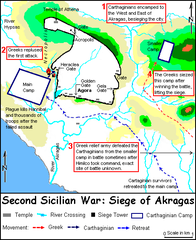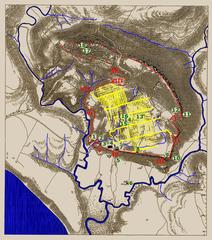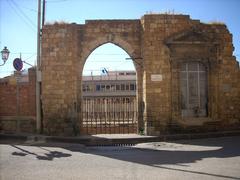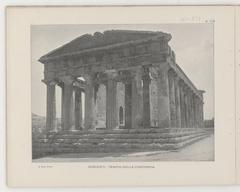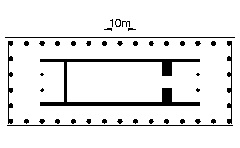Comprehensive Guide to Visiting Giardino della Kolymbethra, Agrigento, Italy
Date: 19/07/2024
Introduction
Discover the Giardino della Kolymbethra, a hidden gem located within the Valley of the Temples in Agrigento, Sicily. This verdant oasis offers a unique blend of natural beauty and historical significance, making it an essential destination for history buffs, nature enthusiasts, and casual tourists alike. Originally constructed as a large water reservoir by the ancient Greeks in the 5th century BCE, the garden has evolved through various historical periods, including Roman, Arab, and Renaissance influences, to become the lush sanctuary it is today. (Valley of the Temples) Managed by the Fondo Ambiente Italiano (FAI) since 1999, the Giardino della Kolymbethra has undergone extensive restoration to revive its historical landscape and reintroduce native plant species. (FAI) This guide will provide you with comprehensive information on the garden’s history, cultural significance, visitor amenities, and tips for making the most of your visit.
Table of Contents
- Introduction
- History of Giardino della Kolymbethra
- Visiting Information
- Archaeological Significance
- Cultural and Environmental Impact
- Visitor Experience
- FAQ
- Conclusion
History of Giardino della Kolymbethra
Ancient Origins
The Giardino della Kolymbethra, located in the Valley of the Temples in Agrigento, Italy, is a site of immense historical significance. Its origins date back to the 5th century BCE during the time of the ancient Greek colony of Akragas. The garden was initially created as a large pool or reservoir, known as a “kolymbethra,” which was part of an extensive hydraulic system designed by the Greek engineer Feace. This system was intended to supply water to the city and its surrounding agricultural lands. The pool was fed by a network of underground aqueducts, known as “feaci,” which were marvels of ancient engineering. (Valley of the Temples)
Roman and Medieval Periods
During the Roman period, the kolymbethra continued to serve as a crucial water source. The Romans maintained and possibly expanded the hydraulic system. As the centuries passed and the Roman Empire declined, maintenance of such infrastructure waned. By the medieval period, the kolymbethra had transformed from a functional reservoir into a fertile garden. The Arabs, who ruled Sicily from the 9th to the 11th centuries, introduced advanced agricultural techniques and a variety of new crops, further enriching the garden’s biodiversity. (Sicily History)
Renaissance to Modern Era
The Renaissance period saw renewed interest in classical antiquity, and the Valley of the Temples, including the Giardino della Kolymbethra, became a subject of scholarly interest. However, it wasn’t until the 20th century that significant efforts were made to restore and preserve the site. In the early 1900s, the Italian archaeologist Pirro Marconi conducted excavations that revealed much about the ancient hydraulic systems and the garden’s historical layers.
In 1999, the garden was entrusted to the Fondo Ambiente Italiano (FAI), the Italian National Trust, which undertook extensive restoration work. The FAI’s efforts focused on reviving the garden’s historical landscape, reintroducing native plant species, and making the site accessible to the public. Today, the Giardino della Kolymbethra is a lush, verdant oasis that offers a glimpse into the agricultural practices and natural beauty of ancient Sicily. (FAI)
Visiting Information
- Opening Hours: Monday to Sunday, 9:00 AM to 7:00 PM
- Ticket Prices: €6 for adults, €4 for students and seniors, free for children under 6
- Travel Tips: Wear comfortable shoes, bring water, and visit early in the day to avoid crowds
- Nearby Attractions: Valley of the Temples, Temple of Concordia, Temple of Juno
Archaeological Significance
The Giardino della Kolymbethra is not only a botanical treasure but also an archaeological one. The site contains remnants of the ancient hydraulic systems, including tunnels and aqueducts, which are considered engineering marvels of their time. These structures provide valuable insights into the technological advancements of ancient Greek and Roman civilizations. Archaeological excavations have also uncovered artifacts such as pottery, tools, and coins, which help historians piece together the daily lives of the people who once inhabited the area. (Archaeological Institute of America)
Cultural and Environmental Impact
The restoration of the Giardino della Kolymbethra has had a significant cultural and environmental impact. Culturally, it has revived interest in the ancient history of Agrigento and the Valley of the Temples. The garden serves as an educational resource, offering guided tours and workshops that teach visitors about ancient agricultural practices, local flora, and the historical significance of the site.
Environmentally, the garden plays a crucial role in preserving biodiversity. The FAI has reintroduced numerous native plant species, including citrus trees, olive trees, and various Mediterranean shrubs and herbs. This effort not only enhances the garden’s aesthetic appeal but also supports local wildlife and promotes ecological sustainability. (FAI Environmental Projects)
Visitor Experience
Visitors to the Giardino della Kolymbethra can explore a landscape that has been meticulously restored to reflect its ancient origins. The garden is divided into different sections, each showcasing various plant species and historical features. Guided tours are available, providing in-depth information about the site’s history, archaeological findings, and the restoration process. Additionally, the garden hosts cultural events, such as concerts and exhibitions, which further enrich the visitor experience.
The garden’s location within the Valley of the Temples makes it an integral part of the overall visitor experience in Agrigento. The Valley itself is a UNESCO World Heritage site, renowned for its well-preserved Greek temples, including the Temple of Concordia and the Temple of Juno. A visit to the Giardino della Kolymbethra offers a unique opportunity to explore the intersection of nature, history, and archaeology in one of Italy’s most historically rich regions. (UNESCO)
FAQ
- What are the visiting hours for Giardino della Kolymbethra? The garden is open from 9:00 AM to 7:00 PM, Monday to Sunday.
- How much are the tickets for Giardino della Kolymbethra? Tickets are €6 for adults, €4 for students and seniors, and free for children under 6.
- What should I wear when visiting the garden? Comfortable shoes and sun protection are recommended.
- Are guided tours available? Yes, guided tours are available and provide detailed insights into the garden’s history and restoration.
Conclusion
In summary, the Giardino della Kolymbethra is a site of profound historical and cultural significance. Its origins as an ancient Greek reservoir, its transformation through various historical periods, and its modern restoration make it a unique destination for visitors interested in history, archaeology, and nature. The garden’s preservation and educational efforts ensure that it remains a living testament to the rich heritage of Agrigento and the broader Mediterranean region.
Call to Action
Download our mobile app Audiala for more updates, and follow us on social media.
References
- Valley of the Temples. (n.d.). Retrieved from https://www.valleyofthetemples.com
- Sicily History. (n.d.). Retrieved from https://www.sicilyhistory.com
- Fondo Ambiente Italiano (FAI). (n.d.). Retrieved from https://www.fondoambiente.it
- Archaeological Institute of America. (n.d.). Retrieved from https://www.archaeological.org
- UNESCO. (n.d.). Valley of the Temples. Retrieved from https://whc.unesco.org/en/list/831
